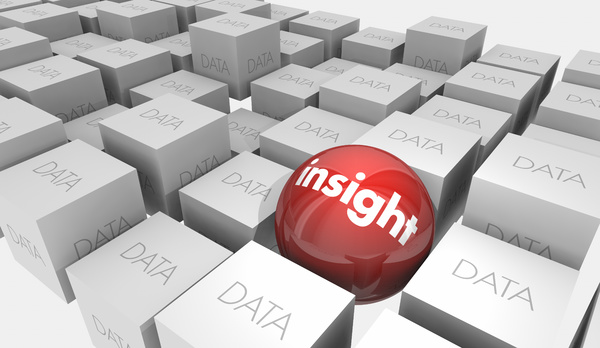
Information vs Data – What Is the Difference?

It’s a complaint we hear from executives at virtually every company we talk to: “We know that we have a ton of data,” they say, “spread out across all the various software systems, databases, and spreadsheets we use in this organization. We just have a hard time bringing it together and analyzing it in a meaningful way.” That, in a nutshell, is the difference between information vs data. Data is a collection of detailed facts about your customers, prospects, products, competitors, and more. After you have organized, verified, enriched, and analyzed that data, it becomes actionable information. Unlike raw data, information empowers business leaders to make better decisions.

Here are the six steps that will help you transform your organization’s data into valuable information.
1. Begin with the Right Data
Successful business analytics projects typically begin with a basic question: Which data sets within your organization could potentially yield actionable information that will help you make better decisions? If you were to gain a better understanding of some particular elements of the business, how might that lead to increased revenue, process efficiency, cost savings, or competitive advantage?
Once you have an answer to that question, you can begin to build a business case around data integrity and analytics. You need not have all the required information available in-house; as we will discuss later, data enrichment affords you the opportunity to add more context using trusted third-party sources.
Read our Report
Data Integrity Trends: Chief Data Officer Perspectives
If you’re considering a data analytics project that will transform your data into information, Precisely can help. As the global leader in data integrity, we offer solutions for integration, data quality and governance, data enrichment, and location intelligence. To learn more about current trends in data quality, download our free report.
2. Integrate and Harmonize
Most sizable organizations house their data across multiple software systems and databases. Some is even stored in local files on individual users’ hard drives. It can be difficult to use this array of disparate data unless your organization is first able to integrate and harmonize it successfully. Unfortunately, the old-fashioned method of exporting and then importing information manually simply isn’t scalable. It’s too tedious and time-consuming, not to mention error-prone.
Given the array of different data sources available within most enterprises, an automated approach is required. Even here, however, there are numerous challenges. Many large companies rely on mainframe systems that don’t readily lend themselves to integration. Hard-coded point-to-point integration requires custom development, which is expensive and must be maintained on an ongoing basis.
Finally, there is the question of flexibility. In today’s rapidly changing organizations, integration must also be easily adaptable as new systems are deployed or old ones decommissioned. Fortunately, with the right enterprise integration tools you can have the best of all worlds: flexibility, scalability, and maximum interoperability.
3. Proactively Attend to Data Quality
Data quality is a key concern for most organizations as well. After all, if you are working with accurate data, you could very well end up making bad decisions based on erroneous information vs data. A typical database containing customer information will suffer a decline in data quality over time, as customers relocate, change their names, or go out of business. In other cases, poor data quality may emerge as a result of human error in the data entry process, incomplete records, or outdated data.
To ensure that your business analytics projects are yielding accurate, meaningful information, it’s critical that you address data quality proactively. Again, it may be possible to monitor and correct data quality errors manually at a very small scale, but to stay on top of it and ensure you’re getting the right information every time, an automated approach is required. The best data quality tools will help your organization catalog and profile its data sources, discover errors and inconsistencies, and bring data quality levels up to par.
4. Add Context with Data Enrichment & Location Intelligence
Your internal corporate data is inherently limited. Your software systems don’t natively have access to the ever-changing world of data about customers, competitors, traffic, weather, and more. Yet by augmenting your existing datasets with that kind of detail, you can deliver vastly more valuable information to decision-makers in your organization.
When a business relies solely on the data it collects directly from its customers, for example, its visibility is limited to a narrow swath of information. By adding demographic information such as income levels, lifestyle preferences, and location-based information, decision-makers can develop much deeper insights into their customer’s needs.
5. Convert Data into Information
Today’s data analytics tools are more powerful than ever. Users have the power to analyze and manipulate information, combine it with data from external sources to add context, visualize trends, and even overlay various forms of information on a map.
Business analytics are not simply about rendering more powerful reports. The best data analytics tools empower users to explore and visualize information based on an array of underlying data sources. Dashboards, geospatial data displays, and other modern analytics tools empower users to explore, learn, and innovate.
6. Make Well-Informed Decisions, then Share Your Successes
Finally, there is the matter of making more effective decisions. Using the information gleaned from your analytics tools, present a case for change. Develop an awareness within your organization of the value you’re able to produce by transforming data into information. Business analytics aren’t about replacing human judgement of course, but they undoubtedly support better decisions.
As with any project, it’s important to look back and assess the results. If you predicted an outcome, was that prediction accurate? Did ensuing events support your decision, or was something missed in the analysis? Might it have helped to have additional data points? Was some element of data quality overlooked? If your project was a success, what might you do to make it even more successful?
By performing this kind of post-project analysis, you can establish a business case for greater investment in analytics. There is an old saying that “nothing succeeds like success.” By showing your work and sharing those wins with other people in your organization, you can set the stage to drive even more business value in the future and show the difference between information vs data.
If you’re considering a data analytics project that will transform your data into information, Precisely can help. As the global leader in data integrity, we offer solutions for integration, data quality and governance, data enrichment, and location intelligence. To learn more about current trends in information vs data quality, download our free report, Data Integrity Trends: Chief Data Officer Perspectives.


